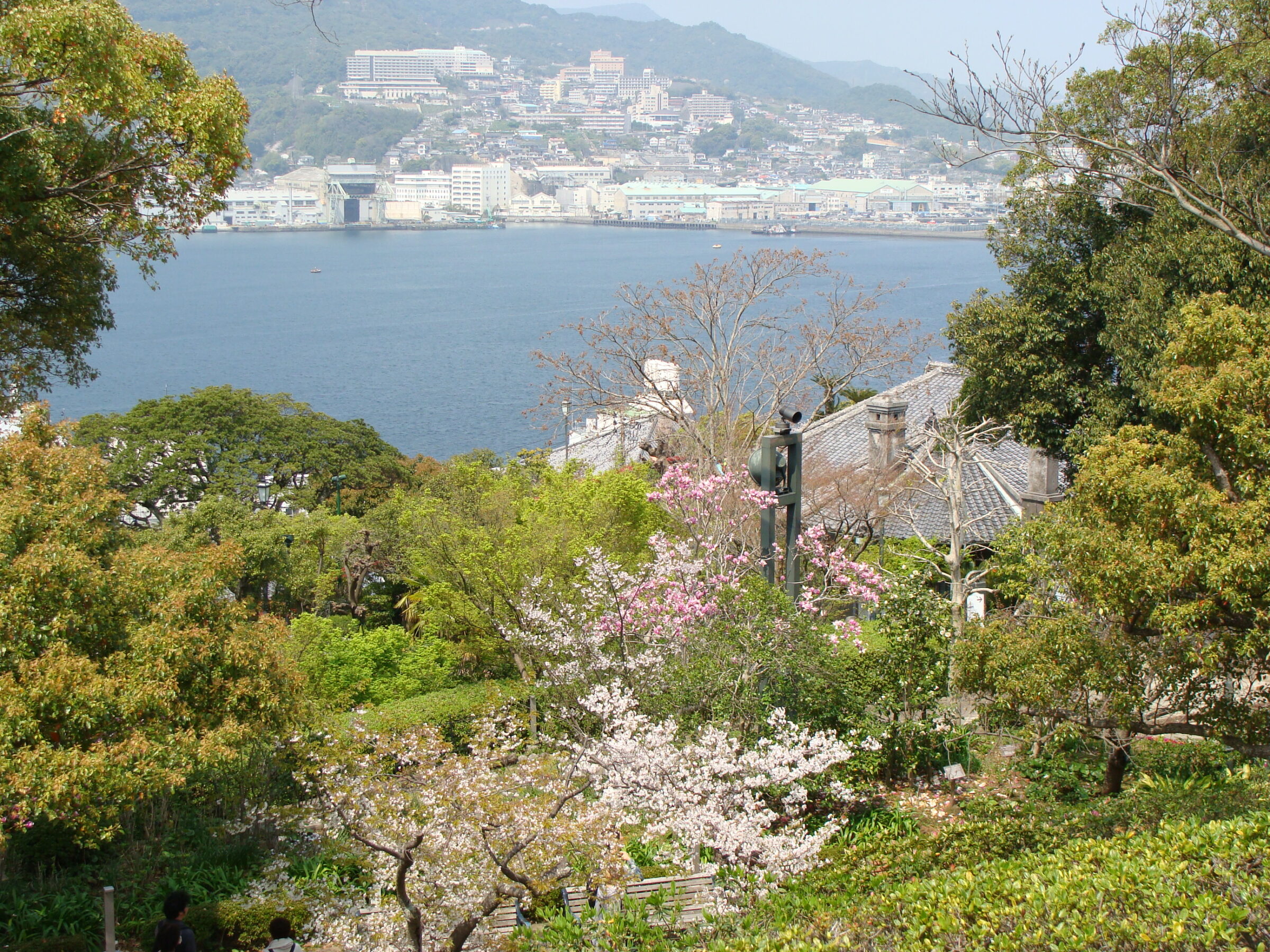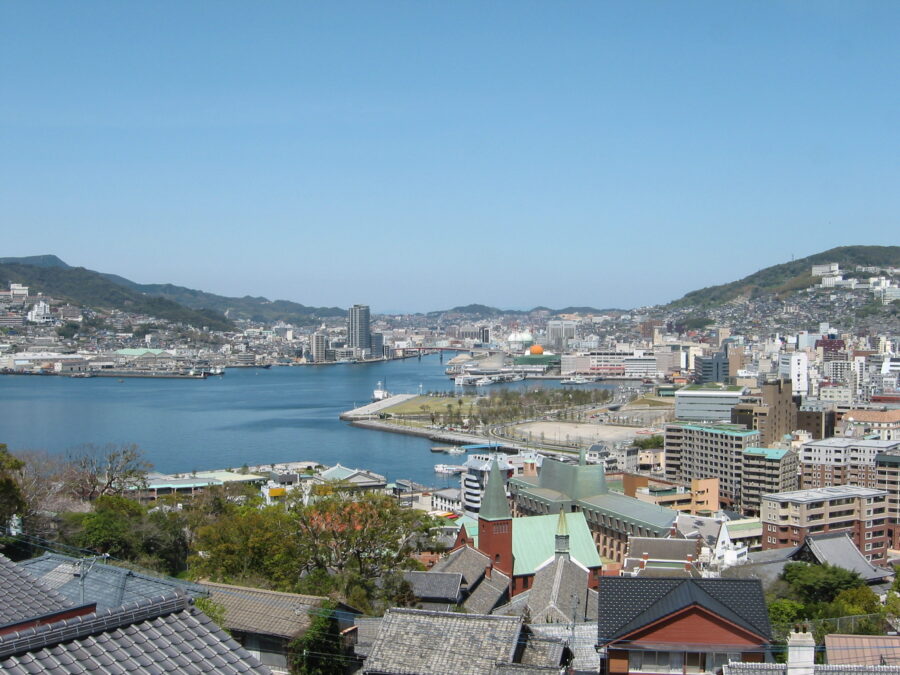Like this post? Help us by sharing it!
The places in-between: Nagasaki
For 220 years, Japan was largely closed to the outside world.
Only those the Shogunate permitted could trade, visit or leave. All trading ports closed – except Nagasaki. The city was one of Japan’s few cultural and commercial exchange points for over two centuries.
Today, as a result, it’s one of the most culturally rich places in Japan – in a way that makes it more “foreign” than other cities, while still feeling deeply Japanese.
With novel ideas, goods and trade, Nagasaki became the crucible for Japan’s industrial revolution that began in the 1860s – largely down to the alliance between Scotsman Thomas Glover and the company that would become Mitsubishi. As a city, it’s home to Japan’s oldest asphalt road and first steam train; as a prefecture, Japan’s first pasta factory (macaroni).
It’s because of this history that Nagasaki is one of the most interesting and multi-cultural Japanese cities you can visit. And in the country where Tokyo is the capital, that’s saying a lot.
Walking through Nagasaki’s city streets, you’ll spot downtown izakaya next to bold, red Chinese temples, and catholic churches alongside Dutch boat festival floats; all characterising a city that comprises a true ‘melting pot’ of cultures.
It’s beautiful, too, overlooked by 360-metre-high Mount Kompira. The Nakashima and Urakami flow to join Nagasaki Bay, and you’ll find rolling tea hills and views over the East China Sea. Heading up the Mount Inasa ropeway at night, you’ll see one of Japan’s top three-night views – the urban Nagasaki lights flicking on at twilight.
But, beauty and vibrancy aside, most importantly, to visit Nagasaki, says InsideJapan co-founder Alastair, “is to understand modern Japan and all its layers of history.”
Nagasaki: the gateway to the West
Step back to 1639, and Japan’s Shogunate government is getting nervous.
Trade with Portugal has been flowing for over 60 years, and it’s not just clocks and Chinese silk they’re bringing ashore, but Christianity too. The ruling Shogunate fear foreign religion could disrupt Japan’s fragile, newfound peace.
So, they shut the gates and tighten their grip on who, and what, comes in and out of the country.
The period is known as sakoku, widely known as Japan’s period of isolation between 1639 and 1853. Although complete isolation isn’t quite correct.
Under strict Shogunate government control, hundreds of Korean delegates shared intellectual and cultural knowledge on diplomatic visits and select Chinese and Dutch traders could trade.
While other ports closed, Nagasaki remained open, with the Dutch only permitted to live and work on Nagasaki’s “exit island” – Dejima. Their legacy? Introducing Japan to chocolate and coffee, which today pack the country’s 4 million vending machines.
Sakoku came to an abrupt end in 1853, when Commodore Matthew C. Perry arrived in Japan with four U.S. warships, demanding that Japan open to U.S. trade. Once again technology, people and ideas flowed through Nagasaki, and a certain Scotsman that would supercharge Japan’s industry arrived by ship.

Thomas Glover – the Scottish samurai
Thomas Glover came to Japan as a merchant in 1859. Helping to establish the shipbuilding company that would become Mitsubishi, he introduced the country’s first steam train – and was heavily involved in selling weapons to, and supporting the education of, young samurai. For this, he earned the nickname the “Scottish samurai”.
Today, Glover’s legacy isn’t just steel and swords. His house and gardens form part of any first-timer’s itinerary in Nagasaki. Alongside the froth of hydrangea blooms and flashes of orange koi in Glover Garden, you’ll find an architectural mix: Japanese tile roofing, British chimneys and mahogany woodwork.
“Picture a classically Japanese garden and what you imagine won’t be Glover Garden, but that doesn’t stop it from being utterly, uniquely Japanese,” says InsideJapan’s Tessa, a recent visitor.
“An escalator bypasses the steep stone stairs up to shady benches. Carefully curated waterfalls line preserved homes of a 19th century expat community. Squint, and you can feel a distinct moment in time: cultural exchange between industrious westerners and entrepreneurial samurais.
“It’s beautiful, and remarkable, too, to think of the impact this place and these people had on shaping the future of Japan. And I can think of no better representation of the cultural exchange infused throughout Nagasaki than tasting a slice of the city’s most famous cake – castella, like Portuguese madeira cake, in the gardens.”

Where foreign flavours become Japanese
From castella cake in Glover Garden to Chinese inspired sara udon in central izakaya bars, “taking something outside of Japan and forming it into something Japanese is an inherent part of the country’s culture,” says Japan specialist Tim. “Nagasaki excels at this, especially when it comes to food.”
“Ask anyone for Nagasaki’s signature dish, and people will say champon, a classically Chinese soup with pork, seafood and vegetables. Its name draws on shanpon, a Chinese word for cooked rice (despite this dish having none), and the Portuguese word for mixing or stirring.”
This fusion approach extends even to tea, something so often seen as quintessentially Japanese. While tea ceremonies in Kyoto and Kanazawa, where geisha and maiko sip from finely painted porcelain, feel deeply traditional, tea was actually first introduced by Buddhist monks from China in the 8th century.
Now, more than a thousand years later, Nagasaki prefecture is reinforcing tea’s status as an internationally recognised Japanese product.
“The tea fields of Nagasaki produce 670 tonnes of tea leaves every year,” explains Dutch-born tea sommelier Marjolien, who works with Nagasaki Ikedoki Tea. “That’s just 1% of Japan’s total output – but the goal is to grow more, and to bring in Western tourism alongside.”
Leading that charge is Yasuharu Matsumoto, known as “Matsu”, who moved from Kyoto to Nagasaki to merge personal dreams with professional purpose. “My ultimate wish is to integrate English-speaking tea tourism, and help farmers reach international markets,” he says. “And, I’ve always wanted to live by the sea”.
As enthusiasts like Matsu blend traditional and foreign influence, with a clear drive forward for the region, it’s evident that Nagasaki’s culinary identity continues to evolve. And visitors can taste it in their morning cup of ocha or their evening meal in Chinatown.
Dragons, Dutch boats and double cheese fries
The transformation of foreign ideas into something joyfully local isn’t limited to what’s on your plate or in your teacup – it’s alive in the rhythm of drums, the swirl of dragon dancers, and the clash of cultures that come together in celebration.
In the past, religion and foreign ideas were a source of perceived danger and persecution – and every import was searched for biblical literature and symbols. Today, Nagasaki’s fusion of cultures comes together at high volume and in full colour during festivals.
Kunchi is Nagasaki’s biggest festival. Every autumn, articulated dragon puppets dance, Dutch boat floats parade through the street, and men dressed in Japanese yukata throw floats into the air in jubilant celebration. It’s a mix of the Dutch, Chinese and Japanese art, colour and traditions that characterise Nagasaki today. As you’d expect, the food is a celebration of east and west too – Chinese steamed buns and double cheese fries are firm local favourites. Kunchi is such a fanfare of festivities that even the Dutch on Dejima were brought ashore each year during sakoku – proof that Japan’s isolation still made exceptions for a good party.
A city for peace and progress
Today, Nagasaki’s celebratory cultural blending is a big part of its personality. But there’s an all-important piece of its recent history that is a tragically core part of Japan’s story.
On the 9th August 1945, 40,000 people were killed when the atomic bomb hit Nagasaki. The city lost 20% of its population.
And that’s something the people of Nagasaki are committed to remembering.
Each day, at 11:02, the time the bomb fell, the Nagasaki Peace Bell rings to remember those who died. While both citizens and visitors can never forget the devastation, Nagasaki’s people have used its tragic past as a catalyst for peace. The Hibakusha (bomb survivors) have been instrumental to the UN Treaty on the Prohibition of Nuclear Weapons (TPNW) – which only entered into force in 2021. In this way, Nagasaki’s impact on peace and progress is stretching into the 21st century – and beyond the country’s borders.
Nagasaki today
From a city hit by tragedy to one defined by resilience, Nagasaki today is embracing peace not only in principle but also in practice, as it grows into a thriving, inclusive modern city.
In a sign that visitor numbers are increasing, for both business and leisure, there has been a recent hotel renaissance. New hotels are opening their doors, from boutique, three-room traditional inn, Tototei, with its cobbled entrance-way and Meiji-era architecture, to sleek, modern brands, like Marriot, which opened its first Nagasaki hotel in 2024. Similarly, tour provider Glide Japan recently launched new city tours and are developing day trips around the nearby volcanic spot of Unzen: “For us, Nagasaki is an urban hub that not many foreign visitors explore – but they should. It has huge potential for tourists: a unique history, diverse communities and crucially, a distinct personality that makes telling its story that much more fun. It’s why we love our jobs so much.”
And the Glide Japan team have plans that extend beyond tourism and into the local community, too. In 2023, they opened Space Beppu (in the eponymous hot spring capital, Beppu) designed to welcome community members of any age, race or gender. They’re hoping to take a similar approach in Nagasaki soon.
“Space Beppu is a place where anyone can come to meet, shop, learn languages or anything else the building’s walls can hold. We want to create a space that welcomes creativity and supports a sense of community both for the city residents and for those who visit – and Nagasaki feels like the perfect fit for that.”

Nagasaki: The place where modern Japan started
At surface level, Nagasaki is a great place to visit. In just one day, you can soak in an outdoor rotenburo on the mountainside, ride the 1950s tramway and eat kakuni soy braised pork in Chinatown.
But what will make your visit stay with you, says Alastair, is the knowledge that without Nagasaki, Japan wouldn’t be the country it is today:
“For me, it’s the place where modern Japan started. You simply cannot comprehend Japan’s development without visiting Nagasaki and understanding it for yourself.
“The clearest way to explain it is that Nagasaki is a reminder that Japan isn’t just Japanese.
“Like any other country, it’s a mosaic of history, cultures, religions and fused experience. Its shared history runs through its communities, food and festivals in a way that isn’t contrived, or overly obvious.
“The longer your stay in Nagasaki, the deeper your understanding can go. Customers often tell us they wish they had more time there, and personally, I am always sad to leave.”



